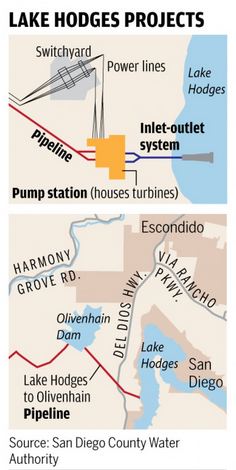
The project consists of three interrelated projects. It connects Lake Hodges to Olivenhain reservoir via an underground pipeline. It generates a peak 40 megawatts of electricity when water descends about 770 feet from Olivenhain into Lake Hodges.
In addition, the project enables the Water Authority to use the water stored in Lake Hodges, which was previously not connected to its reservoir and delivery system. The lake, southwest of Escondido, can provide 20,000 acre-feet of emergency water storage. One acre-foot is the amount used in a year by two typical four-person households.
In the pump-storage system, electricity is generated during the daytime when the cost of power is highest. Water is pumped back uphill to Olivenhain Reservoir when the cost is less. This helps the region get additional energy when it's most needed, and earns money for the water authority, chairman Michael T. Hogan said in a joint press release from the authority and SDG&E.
The twin, 28,000-horsepower pump turbines move water between the reservoirs. One turbine was damaged in February of last year, leaving the other to begin operation a year ago. The second turbine began operation in late August of this year.
The Lake Hodges project is part of the Water Authority’s $1.5 billion Emergency Storage Project, the authority said. The ESP is a system of reservoirs, pipelines and pumping stations designed to store up to a six-month supply in San Diego County in case water imports are interrupted.
The Water Authority says the electricity generated could bring it $2 million to $3 million a year, along with additional savings from lower energy costs.
More information on the Lake Hodges Project and the Emergency Storage Project is available at www.sdcwa.org/lake-hodges-projects and www.sdcwa.org/emergency-storage-project.
 RSS Feed
RSS Feed
